Hair loss is a common concern among both men and women, and while male pattern baldness is well-known, female pattern baldness is a lesser-discussed but equally important issue. Female pattern baldness, also known as androgenetic alopecia, affects a significant number of women worldwide. In this article, we will explore the causes, symptoms, and treatment options for female pattern baldness.
Causes of Female Pattern Baldness
Female pattern baldness is primarily influenced by genetics and hormones. It occurs when hair follicles shrink over time, leading to thinner and finer hair. The exact causes of this condition are not entirely clear, but several factors contribute to its development:
- Genetics: Family history plays a crucial role in female pattern baldness. If your mother or grandmother experienced hair thinning or baldness, you may be more likely to develop it as well.
- Hormones: Hormonal fluctuations are a significant factor in female pattern baldness. Androgens, male hormones present in both men and women, can affect hair follicles. An excess of androgens or increased sensitivity of hair follicles to these hormones can lead to hair loss.
- Age: Female pattern baldness is more common as women age. It often begins after menopause when hormone levels change.
- Medical Conditions: Certain medical conditions such as polycystic ovary syndrome (PCOS) or thyroid disorders can contribute to hormonal imbalances that trigger hair loss.
- Medications: Some medications, such as certain birth control pills, blood thinners, and antidepressants, can cause hair loss as a side effect.
Symptoms of Female Pattern Baldness
The symptoms of female pattern baldness can vary from person to person, but they generally follow a specific pattern:
- Thinning Hair: The most common symptom of female pattern baldness is gradual hair thinning. This often starts at the crown of the head and may be more noticeable when parting your hair.
- Widening Part: As hair loss progresses, the part in your hair may appear wider and more prominent.
- Miniaturized Hair: The hair that remains on your scalp may become finer and shorter in diameter.
- Receding Hairline: Unlike male pattern baldness, which typically results in a receding hairline, female pattern baldness usually preserves the hairline but causes overall thinning.
- Hair Loss on Top of the Head: The central part of the scalp is the most commonly affected area in women with this condition.
Treatment Options for Female Pattern Baldness
While female pattern baldness is a lifelong condition, various treatment options are available to help manage its progression and improve the appearance of the hair. It’s essential to consult with a healthcare professional or dermatologist to determine the most suitable treatment for your specific case. Here are some common treatment options:
- Minoxidil (Rogaine): Minoxidil is an FDA-approved over-the-counter topical medication that can help stimulate hair growth and slow down hair loss in women. It’s available in liquid or foam form and should be applied directly to the scalp.
- Prescription Medications: Some prescription medications, like finasteride (Propecia), may be prescribed to women with female pattern baldness, although they are more commonly used for men. These medications may help inhibit the effects of androgens on hair follicles.
- Platelet-Rich Plasma (PRP) Therapy: PRP therapy involves drawing a small amount of your blood, processing it to concentrate the platelets, and injecting the PRP into your scalp. This treatment is thought to promote hair growth by stimulating the hair follicles.
- Low-Level Laser Therapy (LLLT): LLLT devices, such as laser combs or helmets, emit low-level laser light to stimulate hair follicles and promote hair growth.
- Hair Transplantation: In severe cases of female pattern baldness, hair transplantation surgery may be an option. This involves transplanting hair follicles from one area of the scalp to the thinning or balding areas.
- Lifestyle Changes: Maintaining a healthy lifestyle can also help manage hair loss. Eating a balanced diet, managing stress, and avoiding excessive heat styling or tight hairstyles can all contribute to healthier hair.
Conclusion
Female pattern baldness can be a distressing condition, but with the right knowledge and treatment options, women can take steps to manage and address their hair loss concerns. Consulting with a healthcare professional or dermatologist is crucial for a personalized approach to treatment. While there is no one-size-fits-all solution, many women find relief and improved confidence through the available treatments and strategies for female pattern baldness.
 seolounge
seolounge